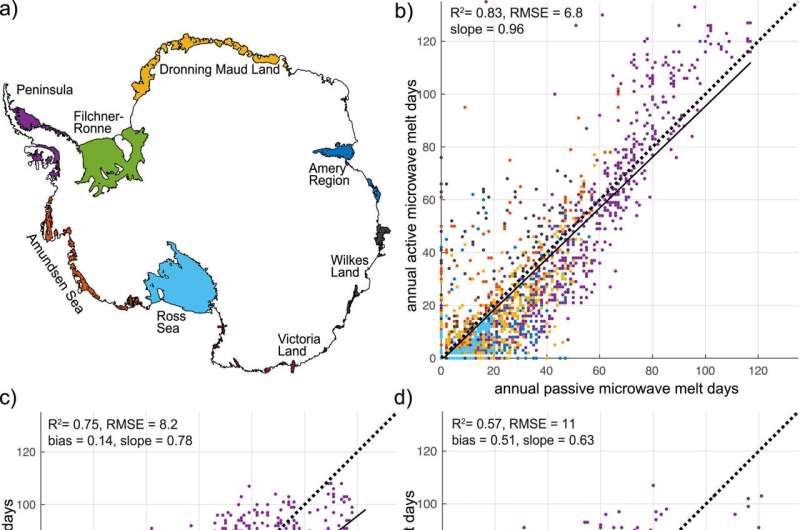This article has been reviewed according to Science X's editorial process and policies. Editors have highlighted the following attributes while ensuring the content's credibility:
fact-checked
peer-reviewed publication
trusted source
proofread
Antarctic ice shelves experienced only minor changes in surface melt since 1980, study finds

Antarctic ice shelves have experienced only minor changes in surface melt rates over the past four decades, unlike the rapid increase in surface melt experienced by Greenland's glaciers during the same time period, according to new research. The news is not cause for celebration just yet, though—the researchers expect Antarctic ice shelf surface melt rates to increase substantially in the coming decades due to rising global air temperatures.
Ice shelves are the parts of glaciers that extend into the ocean and float on top of seawater. In a new study published today in Geophysical Research Letters, glaciologists combined satellite microwave data with computer modeling to quantify how much surface melt occurred on all Antarctic ice shelves from 1980 to 2021.
The study was led by Alison Banwell, a glaciologist at the Cooperative Institute for Research in Environmental Sciences (CIRES), a partnership between the University of Colorado Boulder and the U.S. National Oceanic and Atmospheric Administration.
The results show Antarctic ice shelves overall have seen only minor changes in surface melt rates over the past 40 years, and the modeling results even show a small but significant decrease in melt rates during the study period. However, some ice shelves on the Antarctic Peninsula, which juts out of the continent toward South America, did experience exceptionally high surface melt in recent years, especially during the austral summer of 2019-2020.
The findings appear to be good news for the Antarctic region, but the researchers caution that they do expect Antarctic ice shelves to see higher surface melt in the coming decades. And surface melting is not the only threat ice shelves face; scientists tracking the Thwaites Ice Shelf in West Antarctica have found warm ocean water is eating away at the fragile ice shelf from below.
"As air temperatures increase over the coming decades, we're expecting a real increase in these surface melt rates up until the end of the century," Banwell said. "So although we haven't seen much change in melt rates yet, we will see that to come. It just hasn't really kicked off yet."
Ice shelves help stabilize upstream glaciers from otherwise flowing more rapidly into the ocean, but ice shelves are susceptible to surface melting and melting from warm ocean water below. The polar regions are particularly vulnerable to warming temperatures, and researchers have seen substantial melt on Greenland's ice sheet over the past few decades, but Antarctica's response to climate change has varied. Some areas of the continent, like the Antarctic Peninsula, have warmed dramatically, both other regions have not.
After studying the surface melt of one Antarctic ice shelf from 1980 to 2021, Banwell decided to look at all the continent's ice shelves to see how (and if) they have changed over the past 40 years. Her new study is the first to combine satellite microwave data with a computer model to quantify surface melt over all the continent's ice shelves. The satellite data showed how many days meltwater was present on each ice shelf, while the computer model estimated the volume of meltwater produced on each day there was meltwater present.
The results show that collectively, Antarctic ice shelves experienced hardly any change in surface melt over the past four decades and there was even a small but significant decrease in surface melt, according to the model the researchers used. However, the researchers do expect to see an increase in surface melt in the coming decades. Surface melt makes ice shelves less stable by thinning them and changing how they respond to stress.
"As temperatures increase…melt rates will rise, ice shelves are going to become much less stable as decades go on by the end of the century," Banwell said.
More information: Alison F. Banwell et al, Quantifying Antarctic‐Wide Ice‐Shelf Surface Melt Volume Using Microwave and Firn Model Data: 1980 to 2021, Geophysical Research Letters (2023). DOI: 10.1029/2023GL102744
Journal information: Geophysical Research Letters
Provided by University of Colorado at Boulder




















